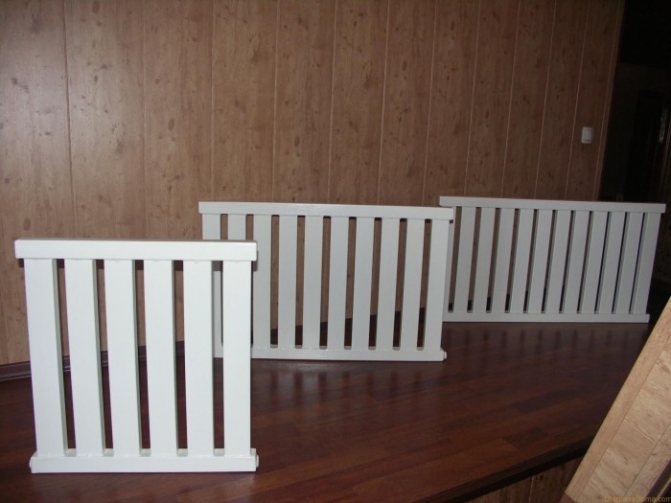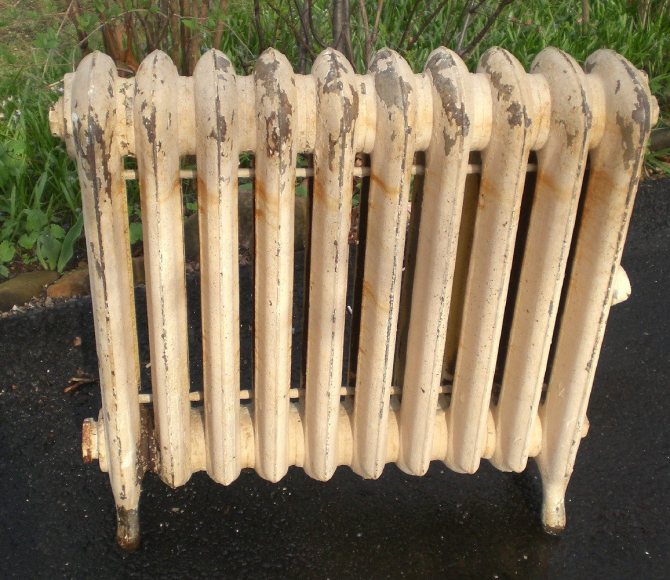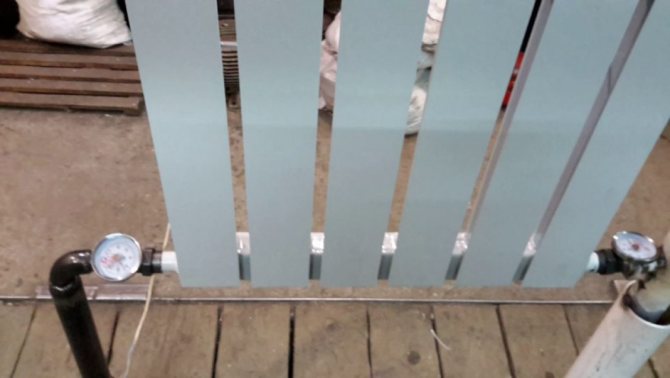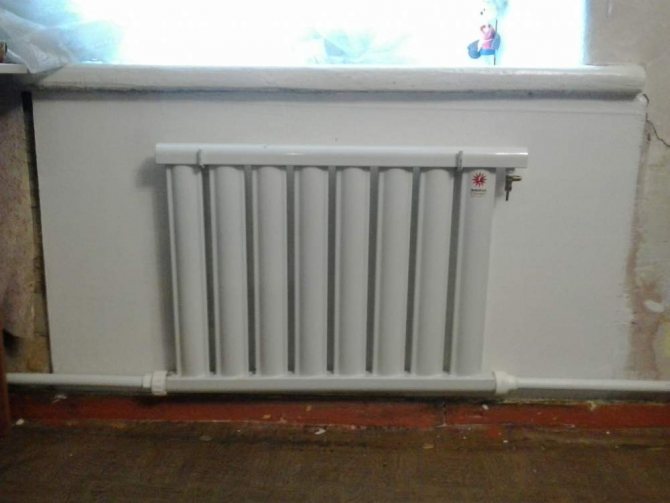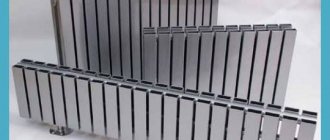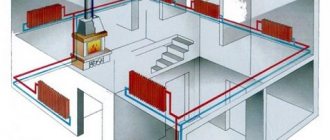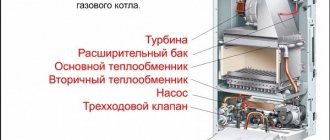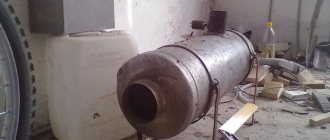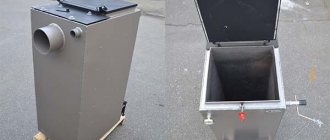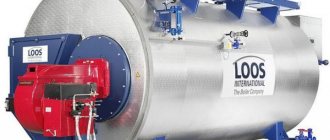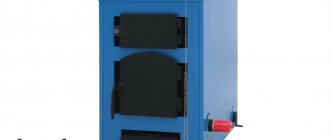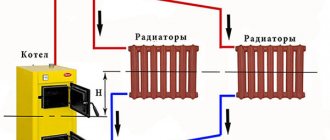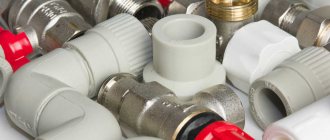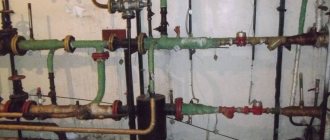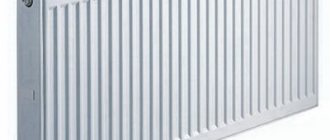In pursuit of increasing the efficiency of heating devices, manufacturers, in addition to traditional cast iron and steel, began to use copper and aluminum in the production of radiators. Later, the idea of creating a vacuum battery came up - due to the clever design, such a heater should instantly warm up, and its power can exceed the best bimetallic counterparts. At the same time, it can be both mobile (electric vacuum radiators can be plugged into an outlet) or flow-through (connected to the heating system).
Vacuum radiator in the interior
Advantages of radiators
- such heating radiators may well work in combination with a wide variety of heat sources, it can be gas or solid fuel boilers, liquid fuel heating units, wood stoves or solar collectors;
- with the use of such radiators, energy savings of up to 30% are achieved;
- savings in coolant consumption is 80%;
- easy installation;
- corrosion resistance of the body material;
- such units are not contaminated as cast iron or aluminum due to the presence of various kinds of contamination particles in the coolant;
- low hydraulic resistance during the passage of the coolant;
- the heat transfer coefficient is very high;
- radiators do not require flushing;
- the level of safety of operation of radiators of this type allows them to be classified as safe.
Having carefully studied the articles on the presented heating devices and after reading the reviews on the Internet, you can safely draw conclusions that the considered vacuum-based radiators are worth at least interested in them.
The price for such devices will be slightly higher than for traditional radiators, however, the savings that will occur in the months of using these devices will force you to consider the price reasonable. The cost of such heating radiators depends on the number of sections, and this directly affects the volume of heated rooms. For example, 12 sections of a vacuum radiator will be enough to heat up to a comfortable temperature in a room with a volume of up to 70m 3.
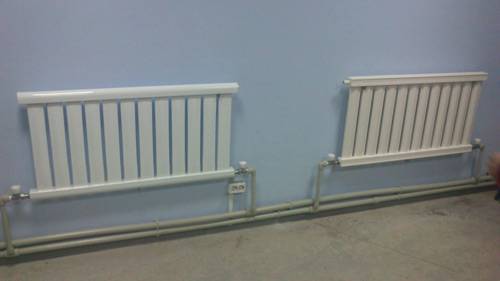
The efficiency of radiators is proven by users
Agree, when using cast iron batteries or aluminum radiators, this effect is unlikely to be achieved. And if it succeeds, then only at the cost of additional insulation of the entire house, including walls, roof and floor.
If you are not yet convinced of the effectiveness of using vacuum heating radiators, we recommend reading reviews on specialized forums where truthful information is presented. Users of such forums leave their comments, which can help you decide. In any case, it is better to read carefully first, and only then buy.
Vacuum heating devices are an excellent alternative to traditional heating devices, a huge step towards the organization of heat supply for various kinds of residential and public buildings, such that they can significantly save energy resources used in heating houses.
System advantages
Heat dissipation vacuum radiators is very high... After all, such a battery can work from a boiler, boiler, stove, even a solar collector. To heat large rooms, boilers with a lower output can be used. In this case, you do not need to heat a lot of water (heat carrier). But one should not also expect that the volume of the energy carrier will be reduced several times.Of course, the savings will be noticeable, but this is not a panacea for bills.
Reviews of vacuum heating radiators show that these are effective innovative devices, which are therefore becoming more widespread nowadays.
And it should be noted several significant advantages of vacuum batteries:
- The volume of the heating medium that is required is reduced by 80%.
- The amount of heat that is consumed from centralized systems will be greatly reduced. Sometimes this figure can reach up to 50%! Of course, the benefit is obvious if all the heat is taken into account by the meters.
- Electricity consumption will be reduced by 30-40 percent.
- Installing a vacuum radiator is very simple - installation is no different from conventional heating radiators.
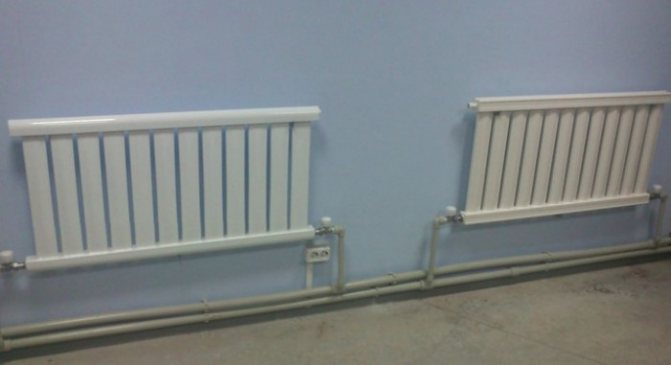

Externally, vacuum radiators do not differ from conventional heating batteries
- The sections of the vacuum battery are not corrosive. Also, here you will not have problems with airing the sections of the heating system.
- Circulation of a small amount of heat carrier will be facilitated due to the fact that the resistance of the liquid mass is reduced.
- The high heat transfer is due to the boiling boron-lithium mixture.
Advantages of a vacuum heating radiator
It can heat a room at a low temperature of the coolant, the main thing is that it is above 35 ° C. This feature of vacuum radiators makes them very convenient for work with heat pumps that use the energy of low-temperature heat sources.
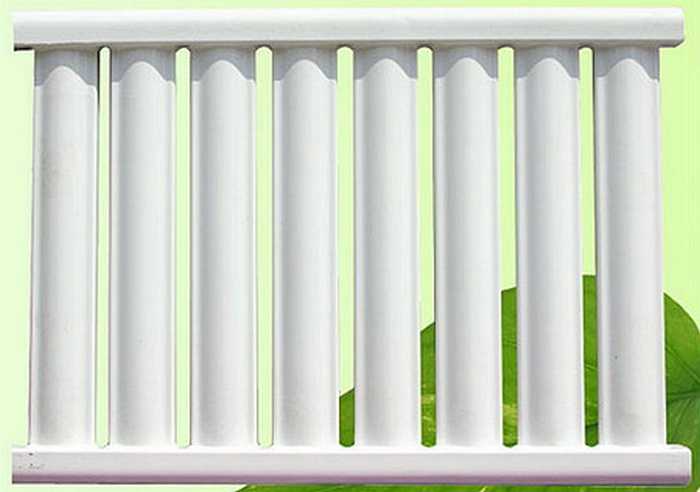

The very high heat transfer rate of the gaseous lithium bromide composition allows heating the heating batteries to the maximum temperature within one to two minutes, which is unattainable for conventional radiators.
Since the coolant in a vacuum radiator is located only in one horizontal pipe, its volume in the battery does not exceed 500 ml (a conventional radiator holds up to 4 liters). Therefore, vacuum heating devices are very beneficial to use in rooms that are heated sporadically and are filled with antifreeze to prevent freezing.
Very easy installation with a minimum of fittings, unions and little installation work.
Virtually no maintenance required. There is no contamination, clogging, corrosion of the battery - all those problems that arise with conventional radiators.
The vacuum heating device is capable of working with any heating boilers. In addition, it can easily be converted into an autonomous heater powered by a low-power heating element inserted into the lower horizontal pipe.
The experience of operating vacuum heating batteries shows a 30 percent savings in boiler fuel. In the event that electric boilers are used, electricity consumption is reduced by 2-3 times.
The disadvantages of vacuum batteries include the relatively high price and crackling noise emitted by the evaporating liquid. In addition, it is necessary to ensure the absolute tightness of the sections with LBZH, which cannot be called completely harmless.
Video: Vacuum heating radiator
What is a vacuum battery?
A vacuum radiator was named because air is completely pumped out of the inner cavity of this steel sectional structure. This is done in order to reduce the pressure.
A liquid substance is placed in hermetically sealed sections, which tends to evaporate easily at a low temperature. Usually it is either ethanol or lithium bromide liquid.
In fact, the work of the vacuum battery is built on the principle of the functioning of a sealed two-phase thermosyphon. Moreover, it has good heat transfer properties.
The system with such devices is fast-response. It quickly enters the operating mode and reacts almost instantly to changes in heat loss.
| Radiator | Heat carrier consumption g / sec. | Heat carrier temperature ° С | Heating surface of the device in% for 2 min. | Heating surface of the device in% for 4 min. |
| Cast iron | 50 | 75 | 25 | 40 |
| Aluminum | 50 | 75 | 45 | 85 |
| Vacuum | 50 | 75 | 70 | 100 |
The table shows the heating efficiency of different radiators. From the surface of the vacuum heating unit, the transfer of heat into the room begins much faster.
The vacuum battery has an optimal ratio between heat radiation and convection in overall heat transfer. The first indicator is 80%, the second is 20%.
How this equipment works
Vacuum radiators have appeared on the domestic market relatively recently, but have already gained considerable popularity among consumers. Visually, these heating devices are not much different from the sectional batteries we are used to. They are made of carbon steel and have a traditionally white or decorated surface.
But vacuum radiators are arranged radically differently. The heating medium of the heating system (water, antifreeze) in the vacuum radiator circulates only through a straight pipe located in its lower part. Instead of water, the sections of the device contain a small amount of lithium-bromide liquid, which boils under vacuum at 35 degrees. The contact of the primary coolant (water) with the secondary (special liquid) occurs exclusively through the metal surface of the pipe.
The principle of operation of the vacuum radiator is as follows:
- The water from the heating system enters the lower part of the radiator.
- Heat is transferred to the secondary heat carrier.
- The working fluid turns into a vaporous state.
- Powerful evaporation quickly and evenly heats up the metal body of the device and the radiator gives off heat to the surrounding air.
- Condensate goes down along the inner walls of the sections, and then, boiling, turns into steam again.
One section of a vacuum radiator contains only 50 ml of coolant (for comparison: in an aluminum one - 350 ml). A smaller volume of coolant is easier and faster to heat up - after all, this requires several times less heat. Considering that the lithium bromide liquid begins to "work" at a very low temperature, it is obvious that the energy consumption for heating water in the system when installing vacuum heating radiators will be small. This is the main "trump card" of the equipment in comparison with other water heating units (cast iron, aluminum, bimetallic).
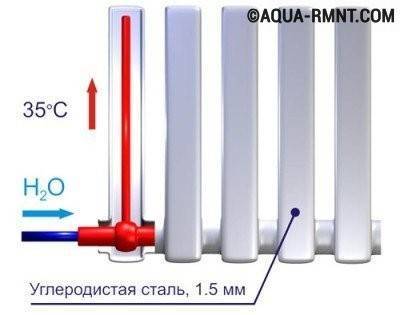

Many are skeptical about the advantages of vacuum radiators, but practice shows that the principle of operation of the units is very effective.
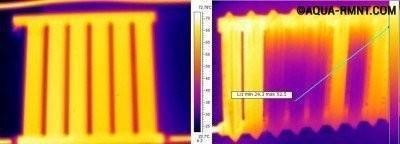

Shooting with a thermal imager confirms the uniform heating of the vacuum radiator and its higher efficiency in comparison with a cast-iron battery
Vacuum radiators are perfectly "combined" with many heat sources - ovens, electric and gas boilers, solar collectors. They are a worthy choice for both autonomous and centralized heating systems. Efficiently heating residential and industrial buildings, vacuum-type radiators are increasingly becoming the confident choice of practical consumers.
More about vacuum heaters
Despite the fact that manufacturers claim a solid set of advantages over conventional batteries, vacuum counterparts are not yet so widespread. Among the main reasons for this, one can single out not only the high cost, but also the lack of significant statistics on their use.
Are the manufacturers' promises true?
The manufacturer of any product seeks to emphasize the advantages of its product and modestly keep silent about its weaknesses. In the case of vacuum radiators, the story is the same, the whole question is how far the reality is from theory and advertising brochures.
You can highlight the following features of vacuum batteries, which sellers are silent about:
- the battery is just an intermediate link, the role of which is simply to transfer energy from the boiler to the house. Accordingly, the heat transfer cannot increase only due to the fact that air was pumped out of it and filled with a low-boiling liquid, the battery is not an energy generator, and does not produce anything by itself;
- vacuum radiators do warm up much faster than thick cast iron batteries. But this does not make much sense, anyway, it will take more than an hour to warm up a standard room. So the gain in a couple of minutes is absolutely insignificant;


The heating rate of different types of batteries is different, but the difference in time does not affect the heating of the house
- corresponds to the truth and the complete absence of air congestion. But in conventional batteries, this has long ceased to be a problem. It is enough just to install the Mayevsky tap in the upper part of the heater and the excess air can be deflated independently;
How to choose a vacuum radiator
Before buying, it makes sense to pay attention to the quality of the product. We can say that the liquid used as a heat carrier is poisonous
Therefore, you should not have any contact with her. In order not to be mistaken, pay attention to the build quality, connections and tightness. Of course, the last point is very important, and it is almost impossible to determine it by eye, but when testing the system, everything will immediately fall into place. In principle, the amount of lithium bromide also plays a role. There shouldn't be too much of it. To check this, take the radiator in your hands and try to swing it. If you only hear a little rustling, then everything is in order. When a transfusion of fluid is heard, this indicates an excess amount. Do not forget that vacuum heating radiators, the principle of operation of which we have already considered, must be completely sealed.
Who is this heating method suitable for?
In most cases, it makes sense to think about buying this type of radiator in the country or in a large country house. This is due to the fact that in rooms with a large area it is necessary to heat a large amount of coolant to a high temperature. And vacuum heating radiators can significantly reduce heating costs. Moreover, the room will heat up much faster. In addition, the radiators have multiple sensors. When the required temperature is reached, they turn off themselves, and the boiler goes into standby mode. What's more interesting: absolutely any boiler will do. It doesn't matter if it runs on solid or liquid fuels. Of course, we cannot say that such batteries do not have their own nuances and drawbacks, they are. But we'll talk about this a little later. Now let's figure out the choice.
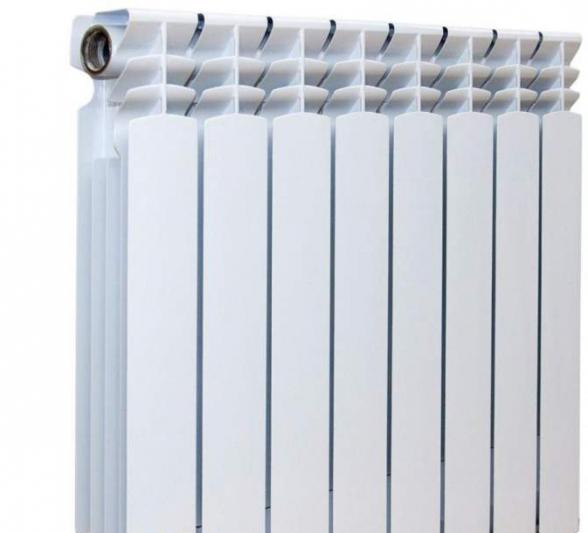

Operating principle
The fundamental difference of such a radiator from a traditional one lies in the fact that its body is filled with a special liquid, which has a boiling point of +35 0 C. The steam generated in this case transfers heat almost instantly over the entire surface of this structure. Within just a couple of minutes, the entire device acquires the temperature of the coolant, which passes through the bottom of the entire structure.
The internal volume of such a coolant in the device is very small and amounts to only 500 ml. For comparison: only one section of the aluminum radiator has a volume of 350 ml. The section of the cast-iron radiator has a volume of 4 liters, which already makes one turn away from this archaism.
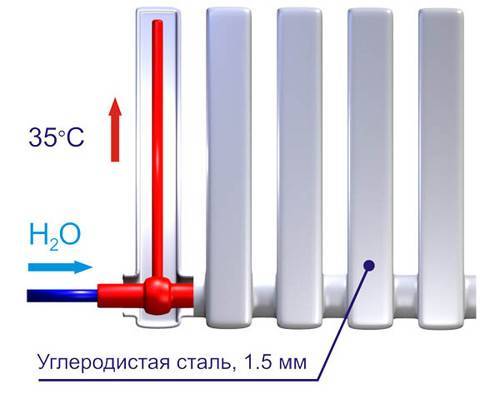

The principle of operation of the heater
The heat carrier in the usual in our view the network must have a temperature of up to + 85-90 0. to heat all the rooms. He must sometimes make a rather long path through each pipe, through each section of all radiators of the heating system, and this takes quite a long time and almost always requires a huge volume of coolant.The presented vacuum heating devices are completely devoid of such a drawback, since the "boiling" of the gas begins to occur already at +35 0. and each column is separate.
The amount of heat transfer from each section of such a heating device can reach a value of about 300 W.
An interesting feature of these radiators: when the device is turned off, the slow motion of the smallest gas particles under vacuum conditions does not allow the radiator to cool down at high speed, that is, the heat remains for a long time.
If vacuum heaters work in combination with liquid and solid fuel boilers, then the fuel consumption is reduced by about half. When an electric boiler is used for heating, then electricity consumption will decrease by about 2.5 - 3 times. Today, even more economical boilers already exist, so that the reduction in heating costs using radiators of the vacuum principle of operation can be very noticeable.
In detail about the principle of action
Since we have already familiarized ourselves with the design a little, I would like to better understand the operation of the device. So, hot water comes from the system, which transfers heat to the lithium bromide solution. Due to the low boiling point, it quickly evaporates, then the condensate flows down and turns into steam again. For this simple reason, intensive cooling of the lower pipe wall occurs. The temperature difference contributes to the fact that the heat flux increases.
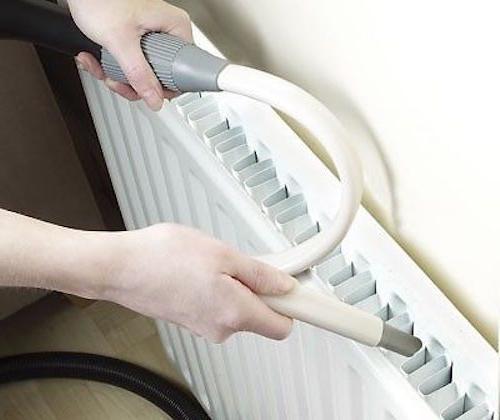

From all this it follows that vacuum heating radiators have such advantages as quick heating and high heat transfer. In addition, for a 10-section radiator, only 0.5 liters of solution is sufficient for efficient operation. To achieve the same effect, it is necessary to pour 4 into a cast-iron battery, and about 3.5 liters of liquid into an aluminum radiator.
On the advantages and disadvantages of vacuum radiators
Most of the advantages of such devices have already been described. For example, a vacuum radiator can run on wood, coal or gas. Electric power supplies are no exception, as well as innovative solutions such as a solar battery, etc. At the same time, the amount of water in the system is reduced to a minimum, by about 70%. It is needed only for heating the coolant. In addition, you can forget about air locks and rusting of the inside of the radiator forever. Most manufacturers have a declared service life of about 30 years, and the efficiency of devices is 98%.
You are probably wondering why then vacuum heating radiators in Moscow, and, in fact, in many other cities of Russia are not very common? It's all about their high cost. However, in Europe, this method of heating a room is very popular, and there are not too many such radiators there.
About EnergyEco
We can safely say that these are the most famous Russian-made vacuum heating radiators. The company manufactures devices from carbon steel with a thickness of 1.5 mm. The approximate heat transfer of one section is 170 kW at an operating pressure of 0.6-1.3 MPa. In principle, a product can withstand a pressure of 2 MPa, and already at 5 MPa it completely collapses. Among consumers, EnerdzhiEko's products have practically no negative reviews, on the contrary, everyone speaks of the high quality of the assembly.
Vacuum radiators in practice
We decided to replace the radiators at home with the already well-known aluminum ones, but when he came to the store, the manager offered another novelty LITHIUM-BROMIDE VACUUM SUPER-CONDUCTING RADIATOR. Demonstrated his work, pouring half a kettle of boiling water, immediately became hot, talked about the advantages, at first glance he was impressed.A question for members of the forum who have already used such radiators at home, how they showed themselves during the heating period, what are the reviews?
Please do not fill your posts with questions about what vacuum radiators are, etc. I will specially leave a link, brief information for review https://teplocel.com.ua/p896400-litievo-bromidnyj-vakuumnyj.h.
The topic was created specifically for feedback from practice. Thank you for understanding!
Reactions to the article
Comments (1)
You write "spent 300 watts can keep the radiator at 100 degrees." So what?
If you turn on a conventional soldering iron with a power consumption of 40 watts, then its tip will heat up to 200 degrees. But this does not mean that with the help of a soldering iron you can heat a room with an area of 20 square meters.
Where does the energy come from. Text is hidden expand
Reactions to a comment
Reactions to a comment
Reactions to a comment
1. The vacuum DOES NOT CONDUCT heat. So there is no vacuum in them. If this is really a heating battery, then it simply MUST conduct heat. Heat is best conducted on materials with a dense crystal lattice (metals).
2. Lithium is used as a coolant, but only lithium -7, that is, lithium isotope. By the way, it is used in nuclear reactors.
3. LiBr lithium bromide is highly hygroscopic (absorbing water well) along with lithium chloride LiCl is used for dehumidification of air and other gases. As a coolant not so hot.
What it is
Device
How does this heater work? In the version designed for hot water heating systems, it is a sealed container of complex shape, through which (through the lower collector) a heating pipe with a coolant passes. The radiator is fully compatible with any of its types; the connection is also quite standard.
The pressure inside the container, although far from the cosmic vacuum, is noticeably lower than the atmospheric one. Part of the volume of the device is filled with its own volatile coolant, which does not come into contact with the external circuit in any way (according to the assurances of the sellers - some kind of lithium-bromide liquid, the exact description of the composition of which is not given).
However: some manufacturers mention the possibility of using ethanol (ethyl alcohol) as a working fluid.
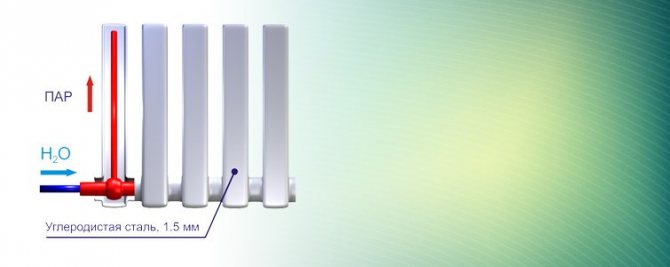

Vacuum radiator device.
Principle of operation
The principle of operation of vacuum heating radiators, according to the assurances of all the same manufacturers and sellers, is reduced to the transfer of heat by a volatile coolant under vacuum conditions:
- When heated to 35C, the lithium bromide liquid boils and actively evaporates;
- Possessing a sufficiently high heat capacity, it transfers heat to the upper part of the heater, providing the fastest (in 1-2 minutes) and uniform heating;
- In the future, due to the special properties of the liquid, it retains a gaseous state for a long time, which does not allow the device to cool down and provides thermal energy savings.
A special case: electric vacuum radiators differ from conventional ones intended for operation in hot water heating circuits by the presence of their own heating element in the lower collector. Thanks to this feature, the heater is only connected to the socket, which greatly simplifies installation.
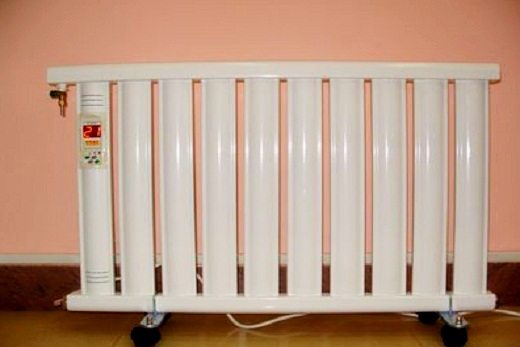

The device is equipped with its own heating element.
Sample research
As an example, we will take the model range of a very specific Energy Eco company. The vacuum radiators produced by it are positioned as follows:
| Model | Dimensions, cm | Number of sections | Heated area, m2 |
| Eco Vacuum 6 | 54x54x4.8 | 6 | 27 |
| Eco Vacuum 8 | 70x54x4.8 | 8 | 36 |
| Eco Vacuum 10 | 86x54x4.8 | 10 | 45 |
| Eco Vacuum 12 | 102x54x4.8 | 12 | 59 |
| Eco Vacuum 14 | 118x54x4.8 | 14 | 63 |
| Eco Vacuum 16 | 134x54x4.8 | 16 | 72 |
A simple calculation shows that one section is capable of providing sufficient heat transfer to heat 4.5 m2 of living space.
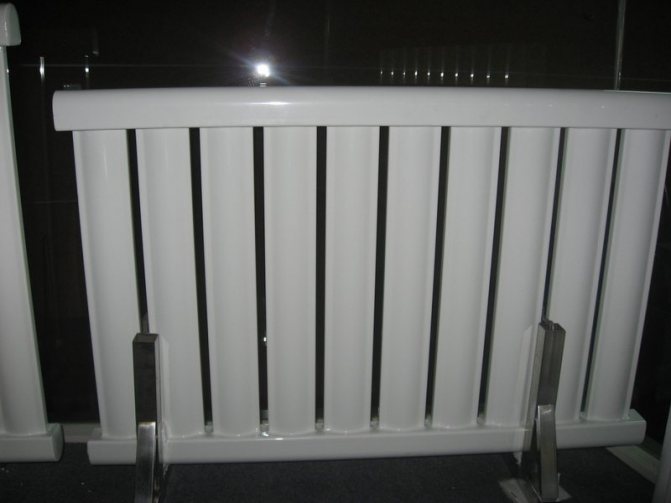

According to the seller's assurances, this device is capable of heating a two-room apartment.
Reference: according to the Soviet SNiP, the thermal power for calculating heating systems is taken equal to 100 watts per 1 m2. In modern energy efficient houses, thanks to comprehensive measures to reduce heat leakage, it can be reduced to 60 watts / m2. Thus, one section of the radiator must provide a heat transfer of at least 4.5 * 60 = 270 watts.
In the description of the technical characteristics of heating devices, the manufacturer places all the dots above the "i":
| Parameter | Value |
| Body material | Carbon steel |
| Case thickness | 1.5 mm |
| Working temperature | 110 C |
| Operating pressure | 6 - 13 kgf / cm2 |
| Mounting thread | DU20 |
| Heat transfer per section | 169 watt |
Once again: 169 watts, not 270. As the well-known character of the unforgettable Mikhail Afanasyevich said: "I congratulate you, citizen, you have lied."
Rules for choosing a vacuum radiator
By opting for vacuum radiators, the buyer is guaranteed to receive the following benefits:
- a significant decrease in the volume of the coolant in the system - by about 80%;
- natural reduction in heating costs. The savings are based on a reduction in the volume of the coolant;
- elimination of internal corrosion of the device case. Only the lower tube can corrode - and then, in the case of using a low-quality coolant;
- impossibility of siltation and blockages of sections;
- low hydraulic resistance;
- high efficiency;
- absence of air congestion in the system;
- minimum costs for equipment installation;
- extremely fast heating of indoor air;
- ease of maintenance of units;
- lightness and aesthetic appeal of devices;
- no need for regular equipment maintenance.
Moreover, vacuum radiators are very durable: under proper operating conditions, their service life can reach 25-30 years. These units demonstrate maximum efficiency in an autonomous system with a low heating boiler output and in a centralized system with installed heat meters.
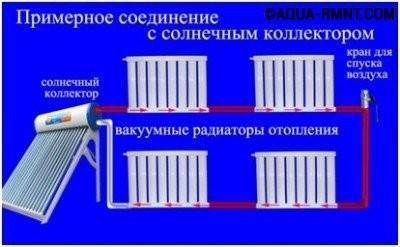

Vacuum radiators and solar collectors are an excellent tandem for creating a modern, highly efficient and economical heating system for a private house.
The simplicity of the design of vacuum radiators allows us to speak of high equipment safety. The devices have only two threaded connections, which are used to connect the device to the heating system. The risk of depressurization on them is practically excluded. When the vacuum battery fails, the "traditional" for water heating radiators "large-scale flood" does not occur
This is another reason to turn your attention to this unique development.
Before purchasing a vacuum radiator, it is imperative to make sure (as far as it is, in principle, possible for an ordinary buyer) in the reliability and compliance of the unit with the established standards:
study the technical documentation attached to the design, make sure that all the necessary certificates are available; shake the radiator to estimate the volume of the lithium bromide mixture
It is very important not to have too much of it. Ideally, there should be a little rustling
The pronounced sound of liquid overflowing, it is highly probable that the battery is of poor quality; carefully inspect the welding seams. Good, even seams are a sure sign of the factory origin of a product. check if the powder coating of the device is damaged by contact with a solvent.
The main disadvantage of the equipment can be called its price - such "pleasure" will definitely cost more than similar solutions.
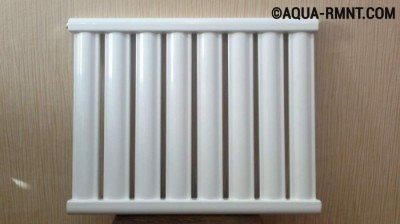

Vacuum radiators are a high-tech product that is a real innovative breakthrough in the production of heating equipment. Therefore, it is not surprising that a lot of low-grade counterfeits of these products have appeared on the market. Buyers are advised to be extremely vigilant when making their choice.
Summarizing
New products should be treated with caution and vacuum batteries are no exception to this rule. Despite loud advertisements, the effectiveness of using such devices raises serious doubts. Quite often, traditional radiators are at least as good as their vacuum counterparts (see also the article “Geothermal heating at home - features and design”).
The video shows an example of a heating system using a vacuum radiator.
Did you like the article? Subscribe to our channel Yandex.Zen
Outcomes
When is it recommended to install a vacuum system for home heating? With the exception of positive reviews about vacuum heating radiators, the installation of a solar system or an expansion tank of the type described are auxiliary mechanisms for improving or optimizing the operation of the heating system.
A powerful vacuum pump for heating will improve water circulation, but will directly affect the thermal regime. The coolant simply does not have time to cool down enough, which is unacceptable for a water-heated floor - mixing flows will not lower the temperature to the desired level.
When choosing and installing other elements of vacuum heating, their features should be taken into account.
Vacuum radiators
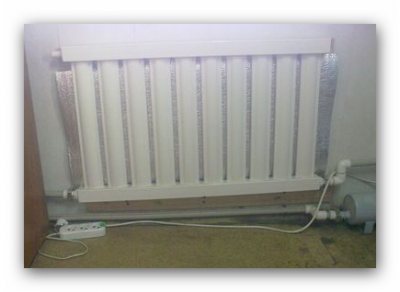

Installed electric vacuum radiator
In addition to thermal power, the rules for installing vacuum heating radiators in a private house are observed.
The minimum distance from the heating surface to the window sill should be 8 cm. Moreover, the level from the floor to the bottom of the battery should also not be less than 4 cm. To improve heat transfer, it is recommended to install heat-reflecting materials on the wall behind the radiator.
Solar collectors
In some models, plain water can be used instead of a special liquid. However, the efficiency of such installations is an order of magnitude lower than that of the above. This point must be checked with the seller.
How to install vacuum batteries with your own hands
For the manufacture of vacuum batteries, a steel sheet with a thickness of 1.5 mm is used. The weight of the device, depending on the dimensions, ranges from 13 to 22 kg, that is, it is not as difficult to lift and install it as the usual cast-iron batteries.
Scheme of connecting the battery to the heating pipeline
The installation of a radiator depends on the heating system. The mobile electric model is just enough to connect to the outlet, stationary batteries must first be fixed in the chosen place, taking into account the following standards:
- the minimum distance to the wall is 5 cm;
- distance from the floor within 2-5 cm from the bottom edge;
- the upper edge is about 10 cm below the windowsill.
Preparatory work:
- before installing the radiator, shake it so that the working fluid is glass down and has the opportunity to come into contact with the coolant;
- it is advisable to insulate the wall behind the battery with foil or other material.
Then, brackets are installed in the selected places, a radiator is attached to them. Central heating pipes are connected to the branch pipes in the lower part and the connections are sealed.
Important! Vapors from the working fluid of the vacuum radiator will affect health. Stop using the appliance at the slightest leak, especially if there are small children and pets in the house.
We install a vacuum heating radiator with our own hands
If you do not want to pay professionals cash for the assembly, then you can really do it yourself. You may not have practice, but it is better to gain knowledge of theory in advance. There is nothing complicated here, and all work takes place in a couple of simple sequential stages.
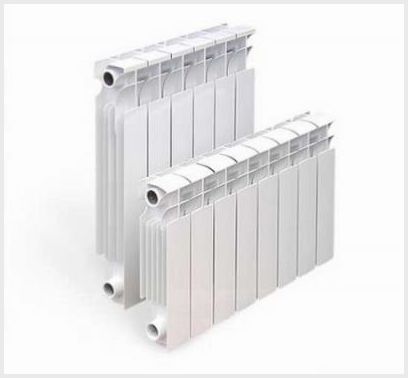

First, you should dismantle the old heating system, if, of course, you have not already done so. For this, the heat carrier is drained in advance. Then apply the fastening points for vacuum heaters. Install the spider fasteners and you need to check them for durability and strength, and only then hang the battery. If for no reason the fastener is not held in place, the heater may fall and be damaged. At another step, ball valves are covered with sealant. For this, a traditional sealant is used. It is necessary to connect the main pipe to the taps and once again implement the sealing of the system.It is necessary to draw your attention to the fact that abrasive material must not be used during the cleaning of the joints. This is because iron particles in the system are hazardous to the pump and seals. At the last stage, a heat carrier is poured into the system.
Design features
When using a conventional heating radiator, it is assumed that a coolant (most often hot water) circulates through it, it warms up, and accordingly the temperature in the room rises.
In this case, such problems may arise as:
- uneven heating - can be caused both by air locks in the battery itself, and by pollution due to the poor quality of the coolant;
Note! If the airlock can be dealt with on your own with the help of the Mayevsky crane, then the contamination of the battery simply cannot be eliminated.
- corrosion of metal... It does not always occur, but when such a phenomenon occurs, the risk of leakage increases, this happens, as a rule, at the most inopportune moment.
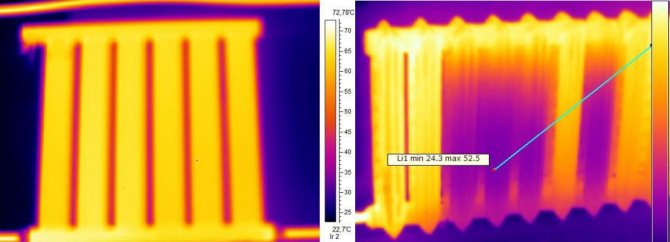

On the left is a thermogram of a vacuum radiator, on the right - a conventional one with air plugs
Vacuum radiators assume a slightly different principle of heat transfer from the coolant to the room. If in a conventional battery the coolant flows through the entire heating device, then in vacuum ones it flows only through a pipe passing through the bottom of the device.
The radiator space is partially filled with a lithium-bromide liquid, and during the manufacture of the device, air is pumped out of it, this is necessary in order to reduce the boiling point of the liquid.
As a result of these manipulations, the manufacturers managed to ensure that the lithium-bromide liquid boils and begins to actively evaporate already at a temperature of about 35 ° C.
The work process looks something like this:
- the boiler quickly heats up the coolant;
- that flows through the pipe through the heating radiators;
- lithium bromide liquid in a matter of seconds heats up to boiling point and evaporates, vapors rise to the top of the device;
- here their temperature begins to decrease and vapor condensation occurs;
- on the inner surface of the walls, drops of liquid flow down and the cycle repeats.
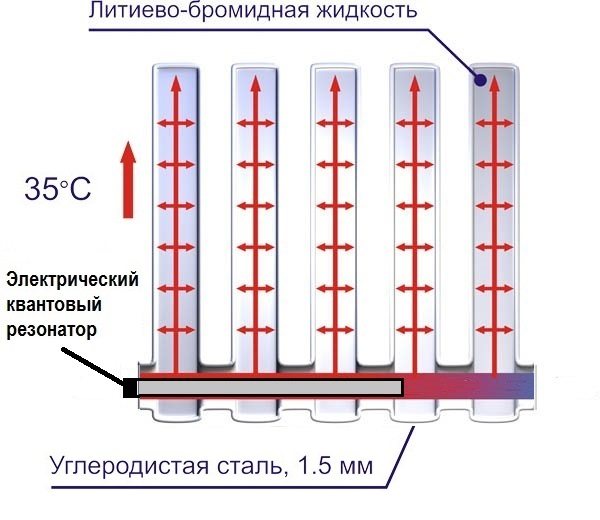

The principle of the heater
Absolutely all vacuum radiators, both flow-through and electric, work according to this scheme. The whole difference lies in the fact that in the former, a pipe with a coolant is used for heating, and in electric ones, a heating element mounted in the lower part of the device.
A little bit about the device
We can say that a vacuum heating radiator is not a revolutionary discovery. It has been known for a long time, but it is a different matter that it has acquired demand only now. The device is quite simple. In appearance we have a traditional sectional heating device, but not water is used as a heat carrier, but a lithium-bromide solution, which begins to boil already at +35 degrees Celsius. To reduce the system pressure as much as possible, it is necessary to completely remove air from there, hence the name - vacuum. Water flows from the bottom of the heater, which does not border on the heat carrier. These liquids come into contact through the metal pipe wall. It turns out that the water heats up the heat carrier, which very quickly returns heat to the walls of the heater.

